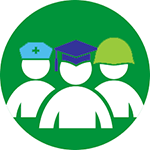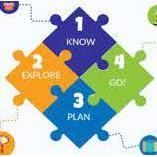About
The Career Readiness Hub is sponsored by the Wisconsin Department of Public Instruction to ensure more equitable access to career readiness materials so ALL Wisconsin students have the opportunity to graduate ready for career, community, and lifelong learning.
Educator Resources will help you learn about the legal requirements related to career readiness found in the Education for Employment and Academic and Career Planning statutes and administrative codes. You will also find professional development resources for career pathways, the Wisconsin Career Readiness Standards, and career-connected learning!
Student Resources provide ready to use activities and videos for every stage of the academic and career planning process as well as all of the career pathways or clusters.
Any questions or suggestions regarding this hub can be directed to Karin.Smith@dpi.wi.gov
Enjoy!
Has your district developed some great career readiness resources that you're willing to share as OERs? Go to the "Join Us" section and become a member of the Wisconsin District ACP Resources group! This open group will allow Wisconsin educators to share resources and connect through a discussion board to enhance ACP delivery in Wisconsin!
Career Readiness Matters
Four reasons why career readiness in K12 education is critical:
- When students choose courses that align to their career interests, their sense of belonging and engagement in learning increases.
- Career exploration helps students find the relevance in their classes and increases academic motivation. These are ESSENTIAL when learning takes place remotely.
- Students have access to the guidance and support they need when they need it. We must make sure ALL students have a plan for success after high school.
- Students are better equipped to succeed, whether job opportunities are plentiful or become more scarce.
Professional Development Resources for Educators
-
Creating a Career Readiness Team
5 Resources
-
Labor Market Information
1 Resource
-
Career Readiness Professional Development for Staff
1 Resource
-
Family Engagement in Career Readiness
3 Resources
-
Community Partnerships for Career Readiness
3 Resources
-
Providing Individualized ACP Support for Students
3 Resources
-
ACP Access for All Students
13 Resources
-
Creating a Formal ACP Process
14 Resources
-
Xello
3 Resources
-
Developing Your ACP Goals
5 Resources
-
Utilizing Career Readiness Data
2 Resources
Student Activities and Videos
-
Agriculture, Food, and Natural Resources Pathway
26 Resources
-
Architecture & Construction Pathway
13 Resources
-
Business Administration Pathway
272 Resources
-
Education & Training Pathway
8 Resources
-
Energy Pathway
470 Resources
-
Health Sciences Pathway
120 Resources
-
Hospitality, Culinary, and Tourism Pathway
7 Resources
-
Information Technology Pathway
25 Resources
-
Manufacturing Pathway
55 Resources
-
STEM Careers
90 Resources
OER Onboarding
Welcome and OER Onboarding - YOU matter! We know you’ve been busy discovering and creating resources to deliver Academic and Career Planning to your students. Through the WISELearn platform, we’re dedicated to helping you share Open Education Resources with other educators across the state.
What exactly is an Open Education Resource? A resource is truly OER if it contains digital content that align to these five tenets:
- Retain: May make or own copies
- Reuse: Use in a wide variety of ways
- Revise: Adapt, modify, and improve
- Remix: Combine two or more
- Redistribute: Share with others
Is a website with great information which is copyrighted by the company that maintains the website considered OER? NO. How about an original career video that you recorded and uploaded to YouTube? YES, it's OER! Watch the following video to learn more about Open Education Resources and licenses that protect your original content through Creative Commons: video
Create OER with Open Author
The CCR Hub is a community of Wisconsin educators where you can share resources that you’ve created through Open Author. Follow the directions in the video below to get started: “Create OER with Open Author” video
Join Us
Terms & Definitions
Getting lost in all the acronyms and terms used when we talk about career readiness? You’re not alone… so we created a "cheat sheet" for you:
| Terms/Acronyms | Definition |
|---|---|
| Academic and Career Planning (ACP) | ACP is intended to equip students and their families with the tools necessary to make more informed choices about postsecondary education, training, careers for life after high school. It is part of DPI's overall vision for every student to graduate high school academically, socially, emotionally, and life ready. |
| Career-based Learning Experience (CBLE) | Career-based learning experiences (CBLEs) include the universe of ACP business-connected experiences and opportunities that allow K-12 students to participate in career awareness, career exploration, or career development. |
| Career Cluster | Career clusters are broad occupational groupings that serve as an organizing tool, categorizing common knowledge and skill sets for secondary and postsecondary education. Career clusters use 16 broad groups of occupations and 79 pathways (sub-groups). Click HERE for more information. |
| Career and Technical Education (CTE) | Career and Technical Education (CTE) is education that combines academic and technical skills with the knowledge and training needed to succeed in today’s labor market. It provides students with the academic and technical skills, knowledge and training to succeed in future careers. Preparation includes introduction to workplace competencies and provides academic content in a hands-on fashion. Students discover their interests, talents and abilities, which lead to a realistic individualized career plan that is applicable to the world of work. Career and technical education better prepares students for all post high school opportunities, whether that be further education, training, or employment. Click HERE for more information. |
| Career and Technical Student Organization (CTSO) | CTSOs are a basic component of career and technical education programs that support and enhance related school-based and work-based learning. CTSOs provide students with skills and knowledge to succeed in the new global economy |
| CTE Concentrator | Under Perkins V, a CTE Concentrator is defined as a secondary student who has completed at least two CTE courses in a single career pathway throughout their high school career. These two CTE courses do not include any exploratory or career exploration courses or courses that are required for all students. |
| CTE Participant | Under Perkins V, a CTE Participant is defined as a secondary student who has completed (passed) at least one CTE course in the reporting year. |
| Carl D. Perkins Career and Technical Education Act | The Carl D. Perkins Career and Technical Education Act of 2006 (Perkins IV) is a principal source of federal funding to states and discretionary grantees for the improvement of secondary and postsecondary career and technical education programs across the nation. The purpose of the Act is to develop more fully the academic, career, and technical skills of secondary and postsecondary students who elect to enroll in career and technical education programs. Additionally, it allows states and local communities the ability to implement CTE programming that supports the educational needs of students through career preparation along with the current and emerging needs of the local economy. The Perkins Act was reauthorized in 2018 (Perkins V). One of Wisconsin’s primary focus areas was to improve student performance in special populations through focused activities and support. A major focus was increasing employment opportunities for special populations as well as creating a more inclusive workforce. This reauthorization helps students with disabilities secure employment after graduation, by integrating youth into the labor market early. It supports cooperative education which combines academic study and career and technical education (CTE) with work experience in a related field. Click HERE for more information. |
| Career Pathway | In K-12 education, a career pathway is a series of connected career and technical education and training opportunities that move seamlessly into a postsecondary option for a specific career area. |
| Dual Enrollment | Dual enrollment includes a variety of programs through which high school students are enrolled simultaneously in both high school and college to earn both high school and college credit. Such programs make college more affordable for families and introduce students to higher level coursework before they immerse themselves in college life. |
| Industry-recognized credential (IRC) | Industry-recognized credentials allow students to demonstrate the knowledge and skills required to succeed in a specific occupation or industry. However, not all credentials are valued equally in the workforce; in fact, some credentials lead students to dead-end, low-wage jobs. |
| Regional Career Pathway (RCP) | Regional Career Pathways have been developed by local organizations to support a shared vision for future employment opportunities and needs within the community. regional career pathways align education and training with the needs of the local job market, provide a range of post-secondary options, result in a high school diploma with at least one industry-recognized credential, and help students enter or advance within an occupation. Click HERE for more information. |
| Special Populations | Under Perkins V, states and local CTE leaders must report disaggregated data on students from nine special population groups and engage with and enhance their efforts to serve these learners: • Individuals with disabilities • Individuals from economically disadvantaged families, including low-income youth and adults • Individuals preparing for non-traditional fields • Single parents, including single pregnant women • Out-of-workforce individuals • English learners • Individuals experiencing homelessness • Youth who are in, or have aged out of, the foster care system |
| Work-based Learning (WBL) | Work-based learning experiences (WBLs) are a subset of CBLEs that meet the quality and rigor requirements for career and technical education (CTE) as defined in the federal Strengthening Career and Technical Education for the 21st Century Act (Perkins V). |
| Social Emotional Learning (SEL) | The Wisconsin Department of Public Instruction defines social and emotional learning (SEL) as the process through which children and adults acquire and effectively apply the knowledge, attitudes, and skills necessary to understand and manage emotions, set and achieve positive goals, feel and show empathy for others, establish and maintain positive relationships, and make responsible decisions. |

